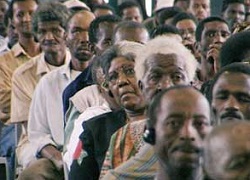After the end of apartheid, as well as the release of political prisoners in the early 90s and the country’s transition from repressive rule to democracy in 1994, South Africa witnessed the establishment of the Truth and Reconciliation Commission in 1995 which formed a crucial component of the transition to full and free democratic country. The TRC was established by the first democratic president Nelson Mandela under the Promotion of National Unity and Reconciliation Act of 1995 and Archbishop Desmond Tutu with Dr Alex Boraine were appointed as its chairperson and vice chairperson respectively.
In all the TRC was comprised of seventeen commissioners: nine men and eight women and divided into three committees (Human Rights Violations Committee, Amnesty Committee, and Reparations and Rehabilitation Committee). The Human Rights Violations Committee gathered testimony of politically motivated gross human rights abuses; the Amnesty Committee dispensed amnesty to perpetrators who gave "full disclosure" of atrocities they had committed for political ends; lastly, the Reparation and Rehabilitation Committee which sought to recommend to the government a policy for providing long-term reparations for victims, as well as short-term relief payments.

The aim of the TRC was to combat impunity and recreate a culture of accountability, and most importantly to uncover truth about gross human rights violations and assist families of the victims in getting closure. In short, “the TRC was a prudent step for reconciling the South African community”.
The broad objectives of the Commission were to promote national unity and reconciliation in a spirit of understanding which transcends the conflicts and divisions of the past by:
- Establishing as complete a picture as possible of the causes, nature and extent of the gross violations of human rights which were committed during the period from 1 March 1960 to the cut-off date including the antecedents, circumstances, factors and context of such violations, as well as the perspectives of the victims and the motives and perspectives of the persons responsible for committing such violations, by conducting investigations and holding hearings;
- Facilitating the granting of amnesty to persons who make full disclosure of all the relevant facts relating to acts associated with a political objective and which comply with the requirements of the Act (Promotion of National Unity and Reconciliation Act);
- Establishing and making known the fate or whereabouts of victims and restoring the human and civil dignity of such victims by granting them an opportunity to relate their own accounts of the violations of which they are the victims, and recommending reparation measures in respect of them;
- Compiling a report providing as comprehensive an account as possible of the activities and findings of the Commission and containing recommendations of measures to prevent the future violations of human rights.
5392 people were refused amnesty and 849 were granted amnesty, out of 7112 petitioners (there were a number of additional categories, such as withdrawn).
Amongst others, the TRC has been criticized for its narrow focus which ‘failed to adequately situate the gross human rights violations in the wider context of apartheid which include forced removals and the expropriation of land, the pass laws, racial classification and related legislatives instead of focusing on political repression’. It has been argued that the South African TRC was criticized for this narrow perspective, in that this presented a ‘compromised truth’ that excluded a large number of victims from the Commission’s scope.

